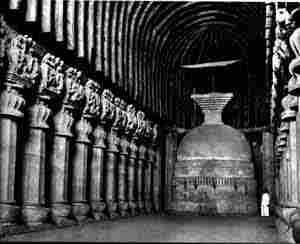|
The Greats Stupa at Sanchi There are heaps of photos of Sanchi on the internet, if you want more, just enter "Sanchi" in your favourite search engine. I scanned
this one in from an old art history book. From around 220BC
to 236AD the Satavahana Dynasty ruled much of Central and
Southern India Sanchi is most famous for its sculptures,
crafted only two or three hundred years after the historical
Buddha left. Most travel sites also have photos of some of
these. |
|
|
The early stupas started as mounds of earth, faced with stone, surrmounted by a three part umbrella. (Representing the Buddha, Dharma, and Sangha).At the very top of the umbrella there was usually a small railing. Around the mound there was a path, for circumambulation. This path was enclosed by a railing, with gates at each of the four directions. The railing and the gates were oftern richly sculptured. If you go looking through the travel pages, you will find many photos of the gates, and their elaborate sculptures, still standing after over 2,000 years. When the British came to India, this stupa was quite delapidated. Buddhism had been virtually wiped out in its country of origin by then. The archaeological Survey of India did a beautiful restoration job. One of the most interesting features of all the sculpture here is the lack of images of the Buddha in human form. He is represented symbolically by a Wheel, or Footprints, or Throne. |
|

